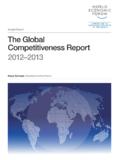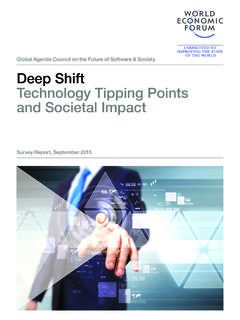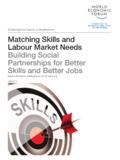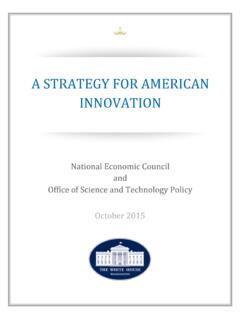Transcription of WEF shaping the future of construction full report
1 Industry Agenda shaping the future of construction A breakthrough in Mindset and Technology Prepared in collaboration with The Boston Consulting Group May 2016. Content Forewords 3. Contributors 6. Context and Objectives of the report 8. Executive Summary 9. 1. Introduction: The construction Industry Time for a Transformation 11. The industry is crucial to society, the economy and the environment 11. The industry's future will be shaped by a number of megatrends 12. The industry must also confront internal challenges 14. The industry is ripe for and capable of transformation 16. 2. Companies as the Spearhead of Transformation 18. Technology, materials and tools 18. Processes and operations 26. Strategy and business model innovation 32. People, organization and culture 36. 3. The Industry As a Whole Needs to Drive Transformation 40.
2 Industry collaboration 40. Joint industry marketing 42. 4. Government Needs to Encourage and Support this Transformation 44. Regulation and policies 44. Public procurement 47. 5. The Way Forward 49. Abbreviations 50. Appendix: future of construction Survey Results 51. Endnotes 55. Bibliography 58. World Economic Forum . 2016 All rights reserved. No part of this publication may be reproduced or transmitted in any form or by any means, including photocopying and recording, or by any information storage and retrieval system. REF 220416. Forewords Foreword from the World Economic Forum The world is changing faster than ever before. Consider just one of the global megatrends shaking up the construction industry: the population of the world's urban areas is increasing by 200,000 people per day, all of whom need affordable housing as well as social, transportation and utility infrastructure.
3 In the face of such challenges, the industry is almost under a moral obligation to transform. Its transformation will have transformative effects elsewhere: on the wider society, by reducing construction costs; on the environment, by improving the use of scarce materials or by making buildings more eco-efficient over time; and on the economy, by narrowing the global infrastructure gap and boosting economic development in general. While most other industries have undergone tremendous changes over the last few decades, and have reaped the benefits of process and product innovations, the Engineering & construction sector has been hesitant about fully embracing the latest technological opportunities, and its labour productivity has stagnated accordingly. This unimpressive track record can be attributed to various internal and external challenges: the persistent fragmentation of the industry, inadequate collaboration with suppliers and contractors, the difficulties in recruiting a talented workforce, and insufficient knowledge transfer from project to project, to name just a few.
4 The industry has vast potential, however, for improving productivity and efficiency, thanks to digitalization, innovative technologies and new construction techniques. Consider the rapid emergence of augmented reality, drones, 3D scanning and printing, Building Information Modelling (BIM), autonomous equipment and advanced building materials all of them have now reached market maturity. By adopting and exploiting these innovations, companies will boost productivity, streamline their project management and procedures, and enhance quality and safety. To capture all this potential will require a committed and concerted effort by the industry across many aspects, from technology, operations and strategy to personnel and regulation. This report begins with an assessment of the industry's present state and the global trends that will impact on the industry.
5 It then introduces a conceptual industry-transformation framework, listing a number of measures, grouped in eight topical areas, that would profoundly change the industry system. The measures are classified into three groups: measures taken by private companies on their own; measures taken by companies in collaboration with their peers or by the industry as a whole; and measures taken by the government, acting both as the regulator and as a major project owner. For each of the topical areas, the report identifies current best practices, and provides illustrative case studies of innovative approaches, to prepare for the industry's transformation. The eight topical areas are: Technology, materials and tools Processes and operations Strategy and business model innovation People, organization and culture Industry collaboration Joint industry marketing Regulation and policies Public procurement shaping the future of construction : A breakthrough in Mindset and Technology 3.
6 The World Economic Forum future of construction project is a collaborative endeavour, aimed at supporting the Engineering & construction sector as it pursues its transformation. (Collaboration is, or should be, a hallmark of the construction industry itself: the industry's future success will rely heavily on effective collaboration among all stakeholders.) The project is planned as a multiyear effort. In its first year, the project is commencing with this wide-ranging report a detailed map to help navigate the current industry transformation. Subsequently, the project will focus on specific topics; for example, the ways that new technologies, materials and processes will improve the project delivery and the life-cycle performance of buildings, and the ways of selecting relevant measures from the industry transformation framework.
7 The report involved input from a great many companies active along the construction value chain suppliers of building materials, chemicals and construction equipment; contractors; and engineering, architecture and planning firms as well as project owners and developers, academics, and leaders from government, civil society, and industry organizations. In this regard, we would like to express our gratitude to the World Economic Forum partner companies that served on the future of construction project Steering Committee: Acciona; Aecon; AkzoNobel; Amec Foster Wheeler; ArcelorMittal; Arup; BASF;. Consolidated Contractors Company; Danfoss; Essar Group; Fluor; Lixil; Perot Group; SAP; Siemens; Skanska; SNC-Lavalin; Tarkett; and WS Atkins. And we extend a special acknowledgement and particular thanks to John M.
8 Beck (Executive Chairman of Aecon Group Inc.), David T. Seaton (Chairman and Chief Executive Officer of Fluor Corporation) and Uwe Kr ger (Chief Executive Officer of WS Atkins) for their unwavering interest in and commitment to the future of construction Initiative. We would also like to thank the many experts who contributed to the report through their role on the future of construction project Advisory Committee: Victor Chen Chuan (Sichuan University), James Dalton (USACE), Juan Elizaga (ENCORD), Timothy Geer (WWF), Tiago Guerra (TG International Manager), Shervin Haghsheno (Karlsruhe Institute of Technology), Franziska Hasselmann (University of St Gallen), Markus Kraft (University of Cambridge), Fiona Murie (BWI), Ibrahim Odeh (Columbia University), Aristeidis Pantelias (University College London), Spiro Pollalis (Harvard Design School), Norbert Pralle (ENCORD), Bob Prieto (Strategic Program Management LLC), Aaron B.
9 Schwarz (Plan A. Architecture + Design), Douglas Stollery (Stollery Charitable Foundation), Jan Van Schoonhoven (Netherlands Government), Enrico Vink (FIDIC), Edmundo Werna, (ILO), and James X. Zhan (UNCTAD). The experience, perspectives and guidance of all the above-mentioned people and organizations have informed and enriched a number of remarkable discussions, notably at the World Economic Forum Annual Meeting of the New Champions, Dalian, September 2015; the future of construction Initiative Steering Committee, New York, December 2016; and the World Economic Forum Annual Meeting 2016 in Davos-Klosters. Pedro Rodrigues de Almeida Manuel Zafra Solas Head of Basic Industries Practice Lead, Engineering and and Member of the Executive construction Industries Committee Infrastructure and Urban Development World Economic Forum World Economic Forum 4 shaping the future of construction : A breakthrough in Mindset and Technology Foreword from the Infrastructure and Urban Development Co-Chair The digital revolution of the last half century has made the world a much smaller place opening markets, creating new products and goods, and facilitating rapid industrialization in emerging economies.
10 The pace of innovation , with improved communication and increased productivity, has been remarkable in many sectors, including health sciences, education and consumer goods. In the automobile industry, for example, robotics, computerized design and a host of other technical and work process innovations have helped to create a global industry that is now more productive and cost-effective, and increasingly environmentally friendly and sustainable. The Engineering and construction (E&C) sector has been slower to adopt and adapt to new technologies than other global sectors. While innovation has occurred to some extent on the enterprise or company level, overall productivity in the sector has remained nearly flat for the last 50 years. As an industry based on competitive procurement models, E&C has historically taken a conservative approach to product design and delivery, leading to silos in project management and a somewhat fragmented industry.














